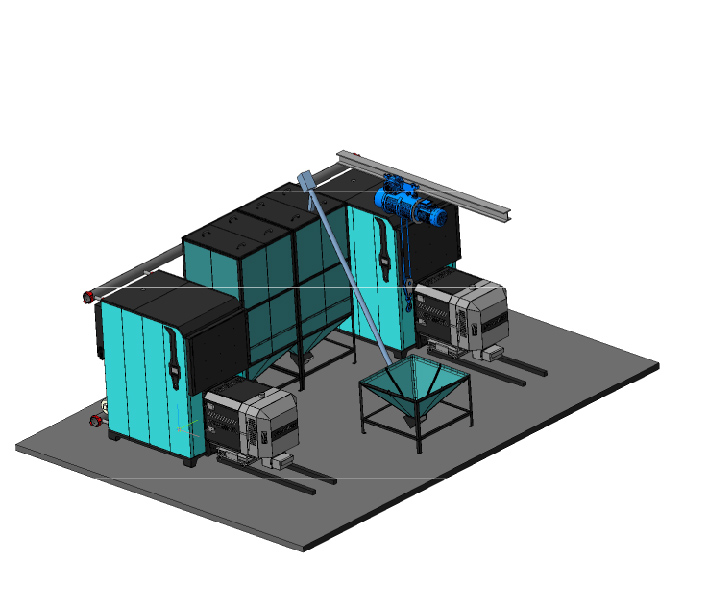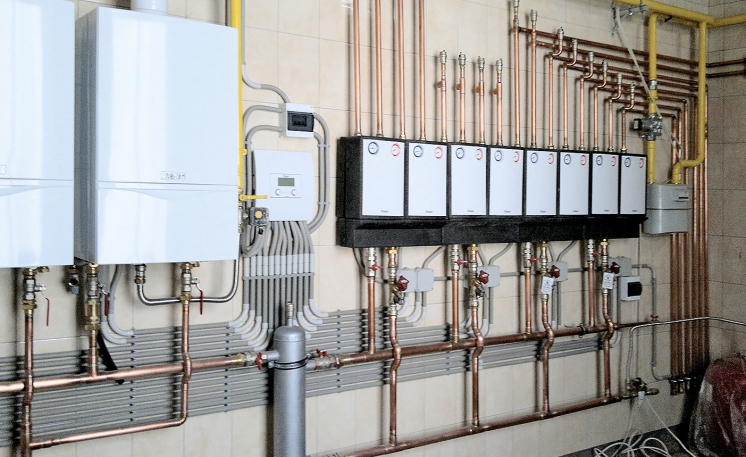Consider the cascade connection of boilers: how to make a 2.2 MW boiler room with little bloodshed
On our website, we constantly talk about compact industrial-class boiler houses, which, thanks to the use of modern design methods and technologies, can completely compete with classic boiler rooms... One of the innovations modern heating systems is a cascade connection of boilers. Applying this engineering approach when using solid fuel boilers FOCUS allows expanding the capacity of heating plants up to 2.2 MW. Cascade connection of boilers is used in domestic and industrial systems. It is a highly cost-effective, versatile approach.
Cascade and series connection of boilers: what is the difference
Cascade connection of boilers is one of the schemes for connecting boilers, which increases the unit capacity of each individual heat source. This method of connection is justified with a high thermal load. Or when it is required to gradually increase the capacity of the boiler room with minimal structural changes to the finished units and heat supply circuits.
Another justified case of using a cascade connection is the connection of boilers operating with different types of fuel. The mixing unit, which is installed in cascade connection, can turn on heat sources as required. For example, according to scenarios, manually, depending on the availability of an energy source or on the weather.
Regardless of the type of connection - cascade or series - the connection of each boiler unit is divided into stages. In the aggregate, the stages of the heating system together form the power of the boiler room.
How a classic household heating system is organized
A classic household heating system is usually provided with heat from one boiler unit, the power of which is selected based on the design and the maximum load of heat consumers. However, even in everyday life, it is necessary to expand the systems, they do not speak about the needs of production workers, for whom an increase in the capacity of the boiler house is almost an annual requirement. The cascade connection of boilers allows you to solve this without making changes to the existing heating system.
But even in everyday life, heating equipment is used 80% time at 50% capacity. But at the peak moments of operation, for example, corresponding to the maximum winter mode in communal boiler houses, high power is required. This issue is solved in different ways, but it is identical for everyday and industrial cases. Some owners install independent heat sources on separate circuits to reduce the cost of installing manifold connections. But the average load of the boiler in such cases will be from 25 to 45%.
Cascade connection of boilers: advantages and disadvantages
Such problems can be solved by the cascade connection of boilers, with the help of which it is possible to meet the needs of an uneven and low heat load. This is also solved with the help of a microcontroller or smart controller and boilers, the power of which is increased dynamically.
In tasks microcontroller includes:
- coolant temperature control;
- keeping track of how many steps need to be turned on to support the workload;
- reduction and increase of power in the system depending on the needs, depending on different parameters.
Due to its functionality, the microcontroller is able to adjust the power over a wide range of values. As a result of this functionality, the controller smoothly adjusts the operation of all boilers in the system with maximum fuel economy.
The advantage of a cascade boiler house is that it can work, providing a low temperature to the coolant in the autumn-spring period. This principle allows you to save on fuel without compromising the level of comfort in the room. Moreover, the adjustment of the temperature indicators in the room can be coordinated with the user's settings in each separate room using a temperature controller.
The cascade connection of boilers of lower power makes it possible to better provide the calculated loads of the heating system than when operating a single unit. However, with an increase in the number of steps, a decrease in efficiency is observed. By increasing heat leakage with an increase in the surface area through which heat loss occurs. As a result, experts do not recommend using more than 4 steps.
It follows from this rule that with the help of 4 solid fuel boilers FOCUS 500 kW each can provide about 2 MW of heat in an industrial boiler house. At the same time, a simple layout of the boiler room is preserved, which does not require costly industrial piping.
Advantages of cascading boilers
For a feasibility study, it is required to highlight the pros and cons of a cascade connection. Of course, in non-professional slang, this list will be called the risks and factors that reduce the efficiency of the boiler room. But we are talking about the practical side of the issue.
Advantages of cascading boilers:
- increasing the efficiency of the boiler room. A smooth increase in power with the connection of other heating units significantly increases the efficiency and reduces the volume of fuel burned;
- increasing system reliability. In case of a cascade connection in the event of failure of one of the boiler units, the system operates in the operating mode, but at a reduced power in the "maximum winter" mode;
- the service life of the equipment increases. Cascade connection of boilers is provided through a special manifold and a hydraulic arrow, such an interface connection has a positive effect on increasing the service life of heating equipment;
- simplified boiler room maintenance. The equipment connected in this way is more compact. Individual heat generators can be taken out of service without stopping the entire heating system. Low-power heat generators are more profitable in terms of finding available spare parts and their prices.
Disadvantages of cascading boilers
Here are the well-known disadvantages of the wiring diagram:
- rather high cost of installation due to the connection of collectors and hydraulic switches, as well as related equipment;
- the boiler room due to the wiring is not so small, this is especially critical for household versions;
- there are difficulties in connecting boilers to the chimney.
Thanks to the cascade connection of boilers, you can confidently deploy powerful boiler rooms with a compact installation of equipment. This approach is very cost effective and suits many manufacturing enterprises. In the next publication we will talk about scheme of cascade connection of boilers.
Get an offer for automation of production heating
Order an industrial boiler house project



